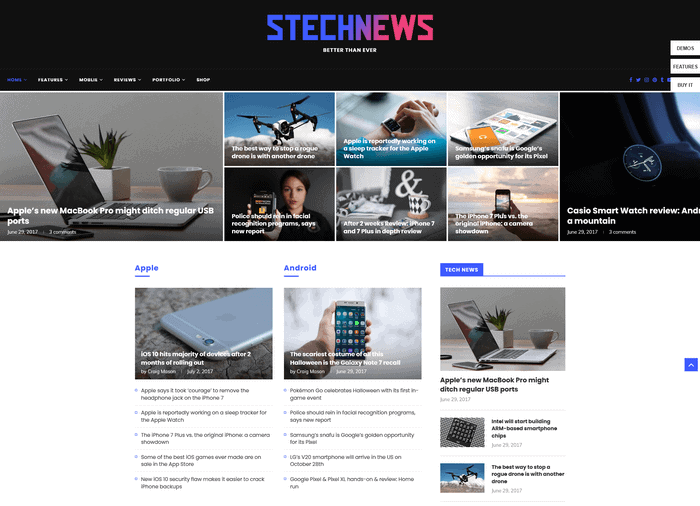What Makes the Best tech blog Stand Out Among Tech Enthusiasts and Experts
What Makes the Best tech blog Stand Out Among Tech Enthusiasts and Experts
Blog Article
Comprehending the Increase of Edge Computing in Today's Digital World
In the quickly progressing landscape of innovation, side computing emerges as a critical force, improving exactly how data is processed and utilized. This standard shift is driven by the proliferation of IoT tools and a rising demand for instant information handling. By transitioning data management closer to the resource, side computer addresses important latency problems while enhancing data transfer usage and enhancing safety and security measures. As sectors pivot in the direction of smarter, a lot more efficient systems, understanding the subtleties and effects of this technological improvement ends up being imperative. What does this mean for future innovations and the electronic ecological community as a whole?
What Is Edge Computer
Edge computer, although a fairly current innovation in the realm of modern technology, essentially changes how information is processed and handled by bringing calculation and data storage closer to the area where it is needed. Unlike standard cloud computer designs, which frequently count on centralized information facilities that can be geographically distant, side computing decentralizes data handling. This closeness reduces latency, improves real-time information processing, and improves the general customer experience by guaranteeing much faster action times.
At its core, side computing involves a network of localized devices and facilities, such as routers, sensors, and gateways, with the ability of refining information at or near the resource. This local handling capability is particularly critical for applications calling for prompt data evaluation, such as autonomous automobiles, commercial automation, and wise cities. Furthermore, by unloading information handling jobs from central web servers, edge computing minimizes bandwidth requirements and enhances information personal privacy and safety and security, as sensitive information can remain on-site as opposed to going across considerable networks.

Key Vehicle Drivers of Adoption
A number of factors are driving the adoption of side computer in today's electronic landscape. Side computing addresses this need by enabling information handling closer to the information source, decreasing latency and boosting real-time decision-making capabilities.
Another significant chauffeur is the demand for improved data transfer performance. Central cloud systems can come to be overloaded with the large quantity of information created by IoT tools, bring about traffic jams (Best tech blog). By processing data at the edge, organizations can minimize network congestion and enhance general system efficiency
Furthermore, safety and personal privacy problems are pushing organizations towards edge computing. By refining sensitive data locally, business can alleviate dangers linked with information transmission and exposure to potential cyber threats.
The surge of applications calling for real-time handling, such as self-governing cars and enhanced reality, additionally demands the quick action times that border computing offers. Collectively, these motorists are making side calculating an indispensable component of contemporary IT framework, paving the method for its widespread fostering across various sectors.
Benefits Over Cloud Computer
How does side computer differentiate itself from traditional cloud computer? Mostly, edge computer brings data handling closer to the source of information generation, often on neighboring servers or neighborhood tools, as opposed to depending on central data facilities. This proximity considerably lowers latency, making it possible for real-time information processing and decision-making. For sectors where milliseconds issue, such as autonomous vehicles or industrial automation, the lowered latency supplied by side computing can be essential.
Furthermore, edge computer improves data transfer effectiveness (Best tech blog). By refining information in learn the facts here now your area, only the necessary data is sent to the cloud for more analysis or storage, decreasing the quantity of information that traverses the network. This not only eases network blockage but also lowers data transmission costs
Edge computing likewise supplies enhanced data privacy and security. Sensitive data can be refined locally without being sent out to the cloud, decreasing the direct exposure to possible cyber hazards. This is specifically advantageous for sectors dealing with confidential details, such as medical care and monetary services.
In addition, edge computer ensures better durability and dependability. Neighborhood processing permits proceeded operation also when connectivity to the cloud is endangered, keeping crucial features and services in spite of prospective network interruptions. These benefits collectively demonstrate side computing's transformative capacity in optimizing efficiency and safety in digital ecological communities.
Obstacles and Considerations
While edge computing supplies various benefits, it also provides one-of-a-kind difficulties and factors to consider that should be addressed to completely realize its capacity. In addition, managing and keeping an eye on a decentralized network of side tools can be complex, calling for innovative devices and strategies to guarantee seamless operation and maintenance. Best tech blog.
Another consideration is the scalability of edge computing solutions. As the number of linked tools grows, so does the demand for refining power at the side, which can bring about source restrictions. Organizations needs to carefully plan their facilities to suit this development without compromising efficiency or performance.
Interoperability is another critical factor. With numerous equipment and software application elements entailed, guaranteeing compatibility and seamless assimilation can be challenging. Standardization initiatives are vital to assist in communication in between inconsonant systems.
Future Patterns in Side Computer
Anticipating the future, side computing is poised to revolutionize numerous industries by making it possible for quicker information handling and reducing latency. As the volume of information produced by IoT devices proceeds to expand, edge computing will certainly become significantly vital in managing this increase successfully.
Another emerging pattern is the advancement of edge-native applications made specifically to take advantage of the one-of-a-kind capabilities of side computer. These applications will certainly optimize performance and source utilization, bring about enhanced effectiveness throughout various industries. In addition, improvements in 5G technology will additionally reinforce edge computer by supplying the required framework for high-speed, low-latency communication in between gadgets and side nodes.
Conclusion
Edge computing's rise is driven by the expansion of IoT tools and the demand for real-time data handling, which boosts performance by reducing latency and decentralizing information administration. This technique reduces transmission capacity inadequacies and security concerns, promoting innovations in applications like independent lorries and clever cities. In spite of difficulties such as infrastructure intricacy and assimilation, the future of edge computing assures a much more responsive electronic environment, with proceeded developments forming its development and expanding its applicability throughout markets.
Edge computer, although a relatively current development in the realm of check my site modern technology, essentially transforms just how information is processed and handled by bringing computation and information storage closer to the area where it is needed. Unlike traditional cloud computer models, which frequently count on centralized information centers that can be geographically remote, edge computer decentralizes data handling. In addition, by offloading information processing jobs from main web servers, side computer try this lowers bandwidth demands and boosts data privacy and protection, as delicate info can remain on-site instead than going across substantial networks.

Report this page